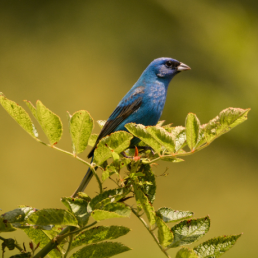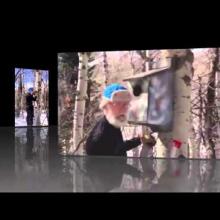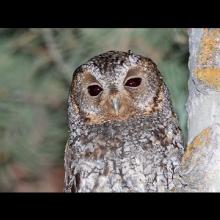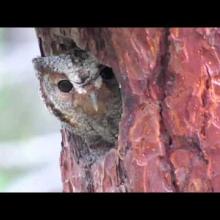

Join BirdNote tomorrow, November 30th!
Illustrator David Sibley and actor H. Jon Benjamin will face off in the bird illustration battle of the century during BirdNote's Year-end Celebration and Auction!
The Flammulated Owl is a study in camouflaged grays and browns, with cinnamon-brown shoulder straps and large brown eyes. This astute aerial predator stands a little more than six and a half inches tall, from its sharp-clawed feet to its stubby, ear-like tufts. It winters in southern Mexico or Guatemala and nests in old woodpecker tree cavities, occasionally evicting the original occupant.
BirdNote®
Flammulated Owl – Summer Visitor
Written by Bob Sundstrom
This is BirdNote!
[Flammulated Owl hoots; crickets chirp]
Just as late-summer darkness fully envelops a mountain pine forest in the West, a male Flammulated Owl begins to hoot.
[Flammulated Owl hoots]
A shimmer of moonlight reveals a tiny owl sitting high in a Ponderosa pine. Abruptly the owl glides out and then hovers momentarily, catching an airborne moth in its talons.
A mere six-and-a-half inches tall but with a sixteen-inch wingspan, the Flammulated Owl seems built much like a large moth itself. It’s a study in camouflaged grays and browns, with cinnamon-brown shoulder-straps and large brown eyes.
The Flammulated Owl nests in old woodpecker tree cavities – and has even been known to evict the occasional woodpecker, if no other cavity is available. Its life and livelihood depend on healthy, mature ponderosa pine forests.
In constant search of insects to feed on, this diminutive owl rates as the most migratory of all the owls that nest in North America. In late summer, the birds will be gone, off to southern Mexico or Guatemala for the winter.
But next spring, along about mid-May, you can hear the Flammulated Owl again, as the stars brighten over the mountain forests.
[Repeat doubled hoots]
For BirdNote, I’m Michael Stein.
###
Hoot of the Flammulated Owl and sound of crickets provided by The Macaulay Library of Natural Sounds at the Cornell Lab of Ornithology, Ithaca, New York. Owl recorded by D.S. Herr; crickets (unedited) by Nigel Tucker.
BirdNote's theme music was composed and played by Nancy Rumbel and John Kessler.
Producer: John Kessler
Executive Producer: Chris Peterson
© 2005 - 2016 Tune In to Nature.org August 2018/2020 Narrator: Michael Stein
ID#080805FLOWKPLU FLOW-01c







